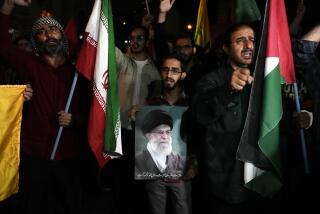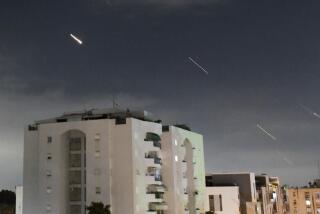NEWS ANALYSIS : Air War Deprives Iraq of Chance for Big Offensive, Other Options, Allies Believe
- Share via
EASTERN SAUDI ARABIA — Allied commanders are discounting earlier fears that Saddam Hussein has adopted a rope-a-dope strategy--absorbing heavy blows in order to marshal his dug-in forces for the “real” war--and now believe Iraq is incapable of initiating and sustaining a major offensive.
They do not discount the possibility that Iraq might launch a major human-wave attack on U.S. lines in an attempt to disrupt plans for an allied offensive, nor do they believe Iraq’s elite Republican Guard troops are incapable of fighting a fierce defensive battle.
The war, they say, could still take some nasty, unpredictable turn that would enable Hussein to drag it out in a style reminiscent of boxing champ Muhammad Ali’s lean-on-the-ropes strategy. But increasingly, the allies’ view is that methodical dismemberment of Iraq’s war machine has denied the Iraqi president realistic military options.
Defense Secretary Dick Cheney and Gen. Colin L. Powell, chairman of the Joint Chiefs of Staff, most certainly heard this message when they met in Riyahd on Saturday with senior U.S. and allied commanders. They, in turn, are believed to have emphasized that the conduct and timing of a possible ground war will be governed to a large extent by the goal of minimizing allied casualties.
“That has to be the No. 1 priority, and it will figure very prominently in the recommendations we make to the President, and I’m sure it will figure very prominently in the decision he makes,” Cheney has said. He also said, as Powell has said before, that in dealing with the Republican Guard, “We’re going to cut it off and kill it.”
To accomplish this, military analysts say that U.S. and allied warplanes are beginning to selectively target Iraqi artillery and tanks with precision bombing. “We have a very good idea of what the targets are and where they are,” Air Force Maj. Bob Baltzer said.
Even with Iraqi tanks buried in sand with only their turrets exposed, aerial photography, visual pilot sightings and satellite imagery can provide a relatively accurate assessment of Iraqi armor and tank positions. Among the bombs being used to take out these Iraqi assets are the laser-guided I-2000s that have destroyed more than 40 bridges. The process of targeting the tanks and artillery guns, though, is relatively slow because each specific target has to be attacked separately.
Although U.S. spokesmen in Riyahd have not said there is any shift in air priorities, the battle damage assessments they have issued in recent days suggest that warplanes are now utilizing precision-bombing to go after Hussein’s main remaining military assets, including artillery pieces and battle tanks.
Once Iraq’s military capability is eroded further, allied planners intend to turn loose up to 2,000 warplanes to bombard Iraqi troop positions in what may be the most concentrated air attack any army has ever had to withstand.
“Our intent is not to dismay anyone,” Maj. Mike Healey, an F/A-18 pilot, said. “Our intent is to kill them.” No senior officer dares say it publicly, but some harbor hopes that an extraordinarily successful air campaign could make an allied ground offensive resemble a mopping-up operation more than a bloody, prolonged confrontation.
Hussein has been noticeably quiet--and out of public sight--for more than a week. Intelligence analysts are unsure what significance to attach to his apparent withdrawal from public view. They also are hard pressed to explain what Hussein thinks he might achieve in the war except to inflict casualties. Clearly, they say, he would risk the destruction of his army to attain that goal.
On Jan. 17, the day the war started, Hussein told his nation in a television address: “. . . With the increase of the combat and the steadfastness of the faithful, success will be written and the presidents and the kings, the traitors will be overthrown. The traitors who have swerved from the right path will be overthrown after the will of evil in the White House and the American hegemony comes to an end.”
Eleven days later, he told CNN in Baghdad that there was not one chance in a million Iraq would lose the war. But in that same interview, he spoke about the war in a way that implied he might be fighting for something other than a military victory.
More to Read
Sign up for Essential California
The most important California stories and recommendations in your inbox every morning.
You may occasionally receive promotional content from the Los Angeles Times.










